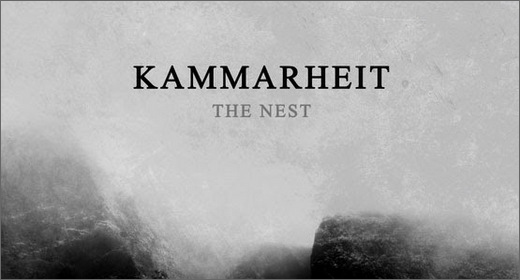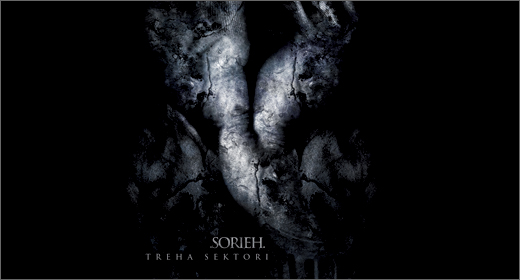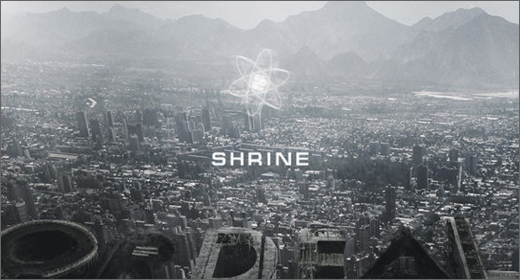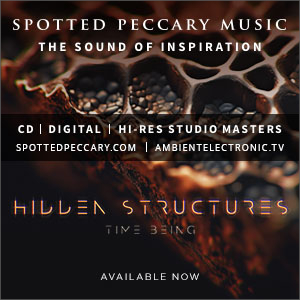The Nest doesn’t give of itself lightly, requiring deep diving, depths-sounding—of cavernous resonance, of bleakness and sustenance—to retrieve ungenerous pearls.
Dark Ambient. Sometimes a great notion. A kind of a marmite of electronic music—enthralling or appalling. The art in it is such that the artless is worse than useless—posturing sub-goth doom-mongering. Pondering what turns base metal to dark gold, though, at the heart of it is not the matter, but the manner of expression—sleight of, and weight of, hand. Between cornball and compelling creepshow is a line the author draws—one way or the other, it’s horror either way. Lustmord defined the territory, dealing with Heresy (Soleilmoon, 1989), The Place Where the Black Stars Hang (Side Effects, 1994), and Stalker (Fathom, 1996), in which space music maven, Robert Rich, had a hand. So the hand is the thing—not heavy, light touch. When the song remains the same—of numina, thanatos and eschaton, all that dark jazz, the grain of the voice is what reveals the true color of Dark.
Pär Boström’s first foray into the dark drone zone followed on a field recording session in an abandoned factory (see Lustmord and Abandoned Power Plants here)–so inspiring he made his debut there. Kammarheit was born, Asleep And Well Hidden (2003), then The Starwheel two years later, and now, 10 years on, he’s back with The Nest. Credit Frédéric Arbour for the audio-visual savvy in curating the Cyclic Law iconography, the Nord Ambient Alliance. An eye for aesthetic—pared-back and pitch-black Cold Meat; an ear to the ground for the sound of a lost world, of abandoned ruins. While much stayed close to DA tropes, some could shake itself loose from mean and misanthropic mould, lift itself out of a generic mire. Kammarheit’s strange sonography transcended provenance, conjuring psychoactive audio documents from an ambiguous sound event horizon: dense sub-harmonic mass, long tone-swathes and rumbling dissonance. The Nest is no departure—if anything, more compelling in its hermetic isolationism. Shadows and fog, rattle and thrum, drone and space, a tarry ooze crawling with unsettling crepitation, designed to draw in even as it repels. The dark drone is ubiquitous, more spatial, less stifling, though still imbued with a creeping sense of some presence behind or beneath—not evil, not malignant, but drained of humanism–a kind of sublimated Nausea, paradise not so much lost as never conceived; against nature, a sort of non-animist anti-pastoral Ambient, not just sulky and wan but bordering on Cosmic angst, slivers of timbre and hints of industrial treatment the only concession to conventions of dynamics and counterpoint in a prevailing mono-tonal palette.
So, let’s take all the DA clichés—about a subterranean journey through vast abandoned halls of unfathomable depths—and refresh them. Let’s then say there’s a presiding spirit here that compels reclamation of some of the original signifying resonance of such worn out words. The Nest doesn’t give of itself lightly, requiring deep diving, depths-sounding—of cavernous resonance, of bleakness and sustenance—to retrieve ungenerous pearls. It cements what may be renewed interest in Kammarheit generated by Unearthed 2000-2002, a 6CD box set bringing to light old material not intended for official release. Created as a palliative for the artist’s chronic insomnia, these slabs of slow decay, endless sustain and reverberant found sound form doleful soundscapes that somehow make of rooms of gloom a place to dwell a while willingly.
The Nest is available on Cyclic Law.



















![Romanowitch :: A critical season substitute (glitch.cool) — [concise]](https://igloomag.com/wp/wp-content/uploads/2025/03/romanowitch-a-critical-season-substitute_tape_feat-75x75.jpg)








